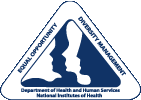|
Affirmative Employment |
Home >Affirmative
Employment
Affirmative EmploymentTargeted Outreach and RecruitmentThe NIH is committed to maintaining its stature as a premier research institution by building an inclusive workforce, fostering an environment that respects the individual and offering an opportunity for each person to develop to his or her full potential in the pursuit and support of science. Through the Workplace Diversity Initiative and Affirmative Action programs, the OEODM assists the NIH Institutes, Centers, and Offices in enhancing the diversity of the NIH scientific and administrative workforce. Our commitment to equal opportunity and diversity in recruiting, hiring, and career development at the NIH will help ensure the continued output of excellent science. Managing Diversity, Equal Employment Opportunity, Affirmative Action, and Special Emphasis Programs"Managing diversity is the process of creating and maintaining
an environment that enables all participants to contribute to their
full potential in pursuit of organizational objectives." Many Federal workforce agencies are implementing diversity initiatives. The NIH is among them. Despite the enormous popularity of these initiatives, it has become increasingly clear that some workers may be confused by the concept of managing diversity. Employees sometimes confuse managing diversity with EEO and affirmative action programs. Some people use the three terms interchangeably. Affirmative action programs are an outgrowth of EEO laws, rules and regulations. Affirmative action is government-initiated and mandated in certain circumstances. It is compliance-based and relies on statistical comparisons of various demographic groups. Affirmative action programs contain goals and timetables designed to bring the level of representation for minority groups and women into parity with relevant and available labor force indices. Affirmative action programs seek limited bottom line results by changing the mix of women, minorities, and persons with disabilities in a particular agency. Affirmative action programs generally cover those groups protected by Title VII of the 1964 Civil Rights Act. Where appropriate, and subject to legal interpretation, agencies may set affirmative employment goals to increase the numbers of women, African Americans, Hispanics, Asians, Native Americans, white males, and people with disabilities. While affirmative action programs are mandated, managing diversity initiatives are voluntary in nature. While affirmative action programs are a reaction to underrepresentation, managing diversity initiatives are proactive. Managing diversity seeks to address issues related to human resources, internal communications, interpersonal relationships, conflict resolution, quality, productivity, and efficiency. Some of the human resource issues addressed by properly managing diversity may be indirectly related to EEO and affirmative action concerns. The main focus of managing diversity is to find productivity gains through respecting, valuing, and using the differences people bring to the workplace. The idea is to find a way to let everyone do what he or she does best in order to gain a competitive edge. While affirmative action seeks an end result, managing diversity is a long-term change process that seeks to identify and actually change the organizational culture of an agency. In the short-term, the NIH needs both an affirmative action plan and a managing diversity strategy. However, as legal restrictions on affirmative action programs continue to tighten and agencies proceed with downsizing and reengineering activities, long-term change strategies will become essential. Regardless of the changes affirmative action may undergo, the NIH will be far ahead of the curve by implementing a Workplace Diversity Initiative early on. The sooner we all learn the differences between managing diversity, EEO and affirmative action, the more prepared we will be to meet the challenges of the new millennium. EEO/Affirmative Action
Managing Diversity
OEODM Serves as advisor and consultant to NIH executives, managers, supervisors, employees, applicants and other interested parties on the NIH EEO and Diversity Program as pertaining to outreach and recruitment, and Special Emphasis Programs (SEP). Targeted Outreach and Recruitment
Special Emphasis Programs
|
Office of Equal Opportunity
& Diversity Management
U.S. Department of Health & Human Services
National Institutes of Health





